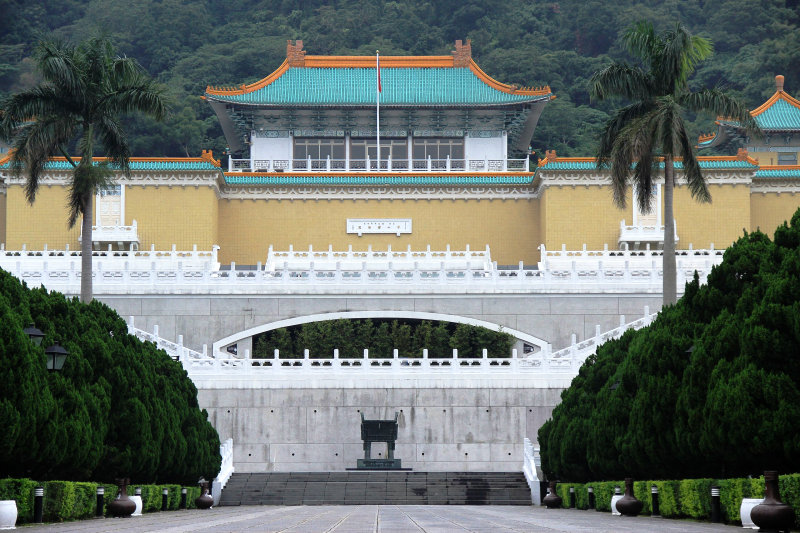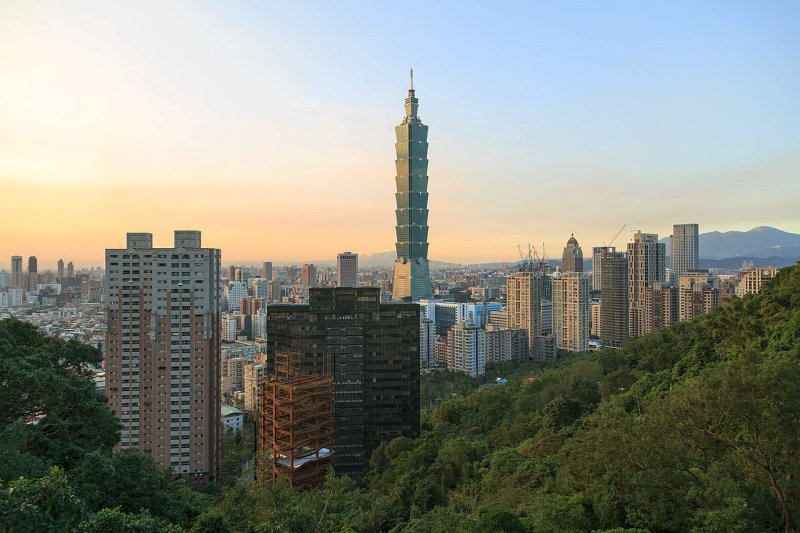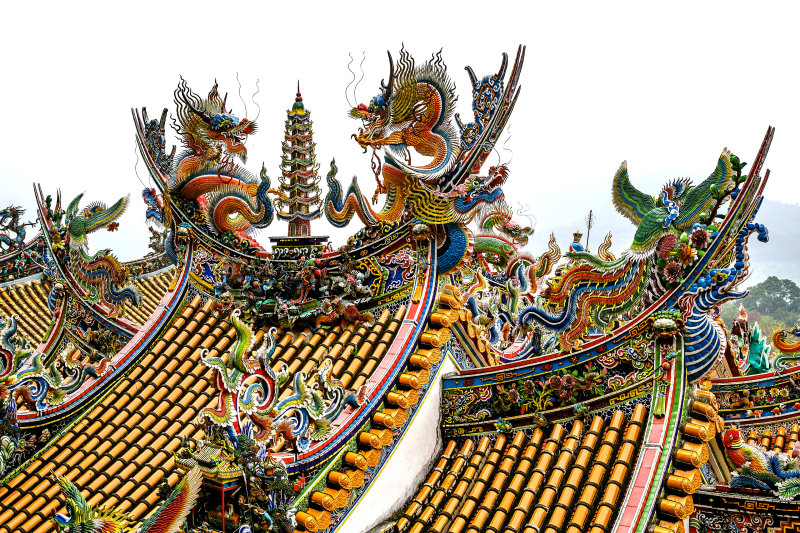One China Policy
This is an opinion piece aimed to stimulate debate in contrast to the other pages of this web site are more carefully researched and aim to be factually correct. The opinions stated here should not be inferred as representing those of the Chinasage web site.
In news bulletins you may hear a reference to a ‘One China Policy’ and your reaction may well be ‘What the hell? - How can there be more than one China’. To understand what this is all about requires looking back at the last seventy odd years because for much of that time there were indeed ‘Two Chinas’.
In the 1930s US poured in huge resources to support Chiang Kaishek and his ‘Nationalist’ party firstly as an ally against Japan and, then when Japan was defeated in 1945, to defeat the Communists. Against all expectations at the time the Communists defeated the Nationalists in 1949. Chiang Kaishek together with an army, money and many treasures retreated to the island of Taiwan. The US navy then intervened by occupying the Taiwan Straits to prevent invasion of the island by the Communists.

Why two?
In the 1950s through to the 1970s the US continued to support Chiang and there was a wide expectation that the Communist government (the People’s Republic of China) would soon fall and Chiang would invade the mainland to become the Chinese leader again. Despite the setbacks in China this did not happen; there was no appetite in China for a return to Nationalist rule. So at this time the US supported the ‘Republic of China’ in Taiwan as the legitimate government of the whole of China with arms and finance while much of the world had by then regarded the communist ‘Peoples Republic of China’ at Beijing as the Chinese government. There were officially “Two Chinas” and this was, not surprisingly, a big issue.
The ‘Formosan Crises’ of 1954-58 nearly brought China and the US into direct conflict with the US threatening to use nuclear missiles even though China had none at the time. The Republic of China had retained a few islands off the Fujian and Zhejiang coast (including Kinmen/Quemoy, Pescadores, Yjiangshan, Matsu islands) and had built up military defenses on them. In 1955 the PRC took control of the Yijiangshan islands by force. Attempts to repeat this at Quemoy were thwarted by considerable US naval and air support. Kinmen (Quemoy 金門縣) remains to this day a strange anomaly, clearly visible just 3 miles [5 kms] from the large port city of Xiamen, a continuing cause of irritation.
This was not just a US political policy, the UN continued to choose representatives from the ‘Republic of China’ (Taiwan) to represent mainland China until 1971. President Nixon brought about a change of policy with his historic visit over fifty years ago (April 1972) to Beijing. US diplomats were now moving towards acknowledging there was only ‘one China’ - the People's Republic. The US's reluctant admission that the People's Republic is the legitimate government of China leaves the island of Taiwan in limbo. From the PRC's perspective it is a renegade province that remains an inalienable part of China. While according to many in the ‘west’ it is an independent entity that is free to choose its own destiny. Currently very few nations have an ‘embassy’ for Taiwan which would confer some sort of legitimacy to it as an independent nation. Any country opening an embassy or welcoming Taiwanese leaders or not including the island as part of China on maps is subject to the wrath of the Chinese government. So the people of the island have limited international standing and no seat at the UN even though it has been independently governed for over seventy years. Currently the west’s perspective is that the PRC's annexation of the island by force would be unacceptable but if the islanders choose to rejoin then that would be their democratic right. The Chinese leadership message is always the same: the island is a ‘renegade’ province that must be reintegrated. It would mark the final defeat of the Guomindang (GMD) Nationalists and final closure of the Chinese Civil War (1945-49).

Principle or Policy?
To complicate matters further some people talk of a ‘One China Principle ➚’ rather than a ‘One China Policy ➚’. China supports the ‘One China Principle’ that has Taiwan as an ‘inalienable’ part of China while the US supports the ‘One China Policy’ that only goes so far as to acknowledge Taiwan is no longer a government in exile and that Beijing is the sole representative of the Chinese mainland. So the ‘One China Principle’ is a much stronger statement of Chinese rights than the ‘One China Policy’ - you have to choose your words very carefully. The Chinese government have the view that the international community has signed up to the ‘One China Principle’ which is not the case, they have only agreed to the ‘One China Policy’ which does not rather fudges the political status of the island.
The history of Taiwan as a province of China does not help to make the situation clear cut. It was only conquered and included in the Chinese Empire as late as 1683. The conquest was not considered a matter of importance, in that year, Emperor Kangxi stated that “Taiwan is outside our empire and of no great consequence”. The fiercely independent indigenous population have had to deal with European colonialists: the Portuguese, Dutch and finally the French. In the declining years of the Qing dynasty (1644-1911) the Japanese took control of the island after defeating China in 1895 and it was ruled by Japan until the end of the Second World War. (1945). So from this perspective the island has been ruled by China for only 212 of the last two thousand years. The Chinese claim of Taiwan as an ‘inalienable part of China’ is very hard to justify from the historical perspective. It was last ruled by Beijing in 1895 (around 130 years ago), no-one living can remember Taiwan ruled as ‘part of China’ from Beijing. This is in part due to the island’s location, it is closest to Fujian which is a mountainous and independently minded province and the island is not a strategic asset. However the historical facts are now somewhat moot. Along with Chiang Kaishek came a huge influx of people from the mainland and that trend continued with the island’s period of prosperity. So it can be argued that the bulk of the islanders are not native Taiwanese but Chinese exiles. But that was some time ago now and the younger generations have never visited China and feel Taiwanese first and Chinese a distant second (for a good CNN article on this see here ➚). The PRC are doing little under President Xi Jinping to charm people on the island into accepting Chinese governance, his policy seems to be to ratchet up the degree of threat step by step.
This ambiguous status leads to another major contention. What should is it be called? The PRC prefers the term ‘Chinese Taipei ➚’ and this is the name used at the Olympics Games. The name ‘Republic of China’ is now rarely used and the old name ‘Formosa’ set by the Portuguese has also disappeared. So the name ‘Taiwan’ seems to be fairly safe choice to avoid upsetting either side.

Current tensions
Any moves to aid or sell arms to the island lead to accusations from China that the ‘One China’ policy is not being upheld. The visit of Nancy Pelosi on 2nd August 2022 ➚ has shown the level of tension over the issue. To me this seems a doubtful argument. The ‘One China’ was all about admitting that the ‘Republic of China’ was no longer a government in exile poised to take over mainland China. The Taiwanese government have not had this ambition for decades, the ‘One China Policy’ does not concern itself with how the island should be administered and so it is not relevant to the current situation. The antagonism of the PRC is not rooted in history but the fact that Taiwan has been heavily supported by a hostile state for the last seventy years. It is not forgotten or forgiven that some US generals had an extremely negative view, General Albert Wedemeyer ➚ took the view that “it was of vital importance that the Communists, even greater enemies of liberties than the Nazis, should not win out in China”. It is also a reminder of the bitter days of Civil War (1945-49) so the position of Taiwan is understandably a strongly politicized and emotional issue.
However it must surely by the case that the wishes of the people of Taiwan should be taken into account? The Chinese government thinks not, the rest of the world thinks self-determination is an important part of the process. It's interesting that polls of Taiwanese do not favor independent status (5.1% in this recent poll ➚) but even fewer, and a diminishing number, (1.3%) favor re-unification with China anytime soon. The vast bulk of the people favor a continuation of the strange status of ‘semi-independence’. The Chinese side dismiss such polls on the basis that the people have been tainted by decades of US support and cannot make a free choice.
Taiwan's future
So what of the future? The Chinese government will not accept the slightest whiff of independence for the island and the US will not accept military conquest by China. There seems no simple compromise so Taiwan may have to learn to live with its status of ‘semi-independence’ for some time to come. There was a time when a ‘One country - Two systems’ approach had backing. This was the approach taken for the former colonies of Hong Kong and Macau - the regions could maintain their own style of administration but be within the Peoples Republic. However this arrangement has not worked well in Hong Kong, which now has very little autonomy and so is no longer an attractive option for independently minded Taiwanese.
There are only a few possible ways forward:
- China annexes Taiwan by force. The Russia-Ukraine war experience may give Beijing cause to wonder if Taiwan would put up a dogged resistance to an overwhelming force just as Ukraine has done. Undoubtedly the 'west' would pour in support if the island did not fall quickly. The sanctions imposed over the Ukraine-Russia conflict may focus some PRC minds as China would (along with the everybody else) be hugely impacted by trade sanctions imposed by the US against China.
- China acts to support PRC loyalists on the island. A more nuanced situation is if and when a significant movement of people in favor of merger with the PRC takes strong root. If these people are harassed then China could step in on the basis it is defending these people's right to self-determination. Recent parallels could be drawn with the annexation of Crimea by Russia.
- Countries (and the UN) gradually change policy to accept Taiwan as an independent nation. Over time if enough countries take this option then China will find it more difficult to justify rejecting Taiwan's right to independent rule.
- A democratic party supporting merger with the PRC grows in popularity and becomes the governing party. Acting against the democratic will of the people would be hard to resist. This change in opinion could come about if Taiwan's economy falters and/or the PRC's continued prosperity and stability makes it an attractive alternative.
There is one way that the waters may be tested by China in order to see the strength of western support. The Chinese armed forces could take the small, scattered Kinmen/Quemoy islands by force as a show of intent. Such an action would showwhether the US still fully support Taiwan. There is no way Taiwanese forces even with US help could prevent thi small scale conquest. This may also weaken Taiwan's resolve to resist a full scale invasion of the main island of Taiwan,.
The 2024 elections demonstrate that the Democratic Progressive Party (DPP) under the leadership Lai Ching-te have the most support. The DPP is the party which is most supportive of independence for Taiwan and the result was met with dismay in Beijing.
So what are my thoughts on the future? There does not seem a short term peaceful solution. A lot may depend on whether a re-elected Donald Trump would seek to resolve the issue one way or another. The most likely scenario is a continuance of the current 'semi-independence' with little change - for all its faults the present arrangements work out fairly well for the people of Taiwan.
For more detailed background to this topic please read our pages on the Republic of China and also Taiwan.
This is an opinion piece aimed to stimulate debate in contrast to the other pages of this web site are more carefully researched and aim to be factually correct. The opinions stated here should not be inferred as representing those of the Chinasage web site.